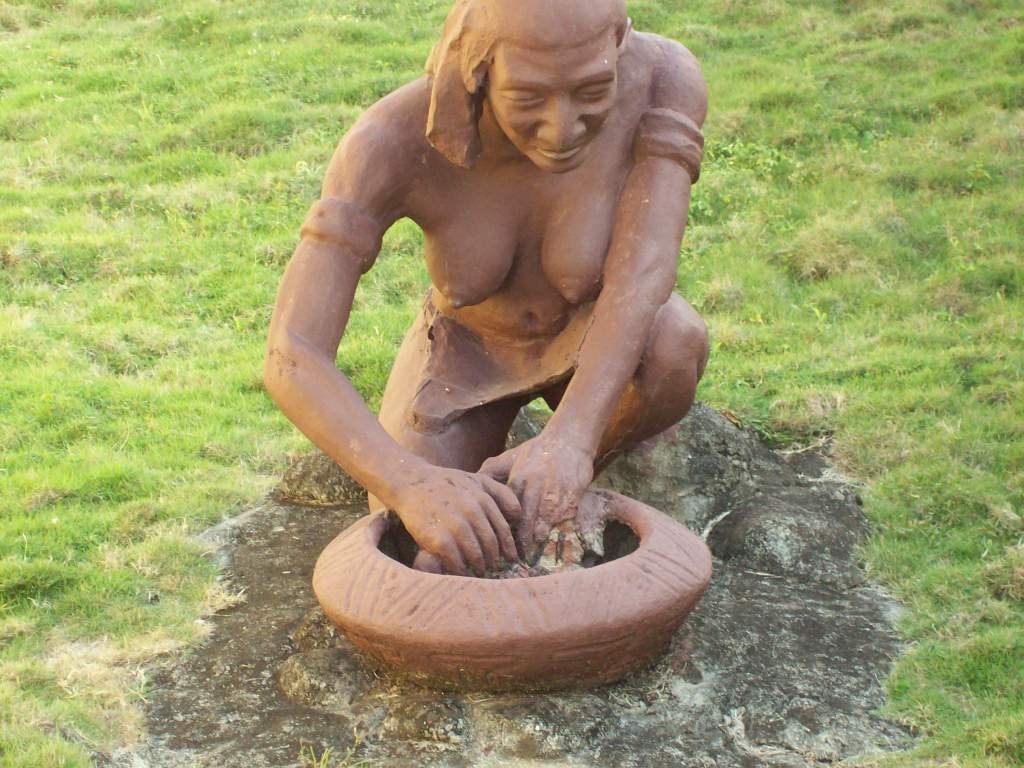The First Cubans

It is speculated that Taíno tribes were forced westward, some two-hundred years before the Spanish arrival, by a bloodthirsty tribe known as Caribs (this is where the word cannibal came from). They would raid a village, kill all of the adult men and consume their flesh. The women were spared for slavery, as were the young men, who were castrated.
In Cuba, the Taínos found a paradise openly available and very suitable for their peaceful lifestyle. The Siboneyes eventually became servants of the Taínos, who were more evolved and technologically advanced.
Typical Taíno societies performed the traditional activities of fishermen and hunters, and introduced agriculture to the island. Their staples included maize (corn), beans, squash, peanuts, yucca, and tobacco. They created a variety of tools and artifacts by polishing stones and carving wood, and they were accomplished potters, crafting a variety of utilitarian pieces and small figurines of animal and human forms, male and female, which represented spirits considered sacred by each community.

The Taínos also made houses, called bohíos, out of cane or bamboo, and formed villages, which were ruled by caciques or behiques, whose functions comprised those of priests, doctors, and chiefs. They also cultivated cotton, using it to weave fishing nets and sleeping hammocks. Tobacco was used for religious, medicinal, and ceremonial purposes.
Taino men wore no clothes, but the women wore skimpy cotton aprons that covered them in front from the waist down to their knees, and both sexes appear to have enjoyed equal status in their society. It is speculated that they were both very sexually promiscuous, and we know for a fact that both sexes were fond of painting their bodies in bright colors, and wearing jewelry made from shiny stones, feathers and shells.
“The indians that Columbus and his men encountered in Cuba were a simple and happy people living in a peaceful and gentle world,” writes Jorge Guillermo in his book, Cuba: Five-Hundred Years of Images. “They had no enemies, human or otherwise, and were therefore unused to combat. Their pathetic inability to resist the Spanish invaders made their eventual submission in the hands of the conquistadores an inevitability.”
By the mid-sixteenth century, Cuba’s indigenous population had dropped to less than a few thousand as a result of disease, mass suicides and Spanish exploitation.
According to historian Louis A. Pérez, Jr., Siboney Indians migrated to the central-western region of Cuba as early as 1000 B.C. By 1000 A.D. they had settled the eastern third of Cuba.
Over the next 400 years, between 1050 and 1450, Arawak Indians (Siboneyes and Taínos) migrated into and across the island, displacing the Siboney from all parts of Cuba except the “western extremities.”
By the time Cristóbal Colón made his way to the island, Siboney and Taíno tribes lived practically in peace, with no major enemies to contend with.
In 1508 Sebastián de Ocampo circumnavigated Cuba, proving that she was an island, and not a peninsula, as Colón had originally speculated.

Diego Velázquez, one of the richest Spaniards in the new world, assumed the role of conqueror of Cuba. He established the first permanent settlement on the island in Baracoa, from which he launched the Spanish conquest of Cuba, which took less than four years to complete (1511-15).
Once the conquest was completed, Velázquez began the practice of issuing encomiendas, in which a Spaniard was issued a native family (or families). The Spanish “encomenderos,” according to historian Jaime Suchlicki’s book Cuba, From Columbus to Castro, “would extract labor and tribute from them while providing for their Christianization.”
An “encomienda” did not include ownership of the land, and the “Indians” were not considered slaves, but “free” subjects of the empire. The “encomenderos,” however, treated their “Indians” as slaves, and those who had survived Velazquez’ “conquest” began to die from forced labor, disease and suicide.
Velazquez served as governor of Cuba, with almost unlimited power, until his death in 1524. In 1538, the official capital of the island was transferred to Havana, and the island stayed under the Spanish empire control for almost 500 years.
Moving to more modern times and check out:
